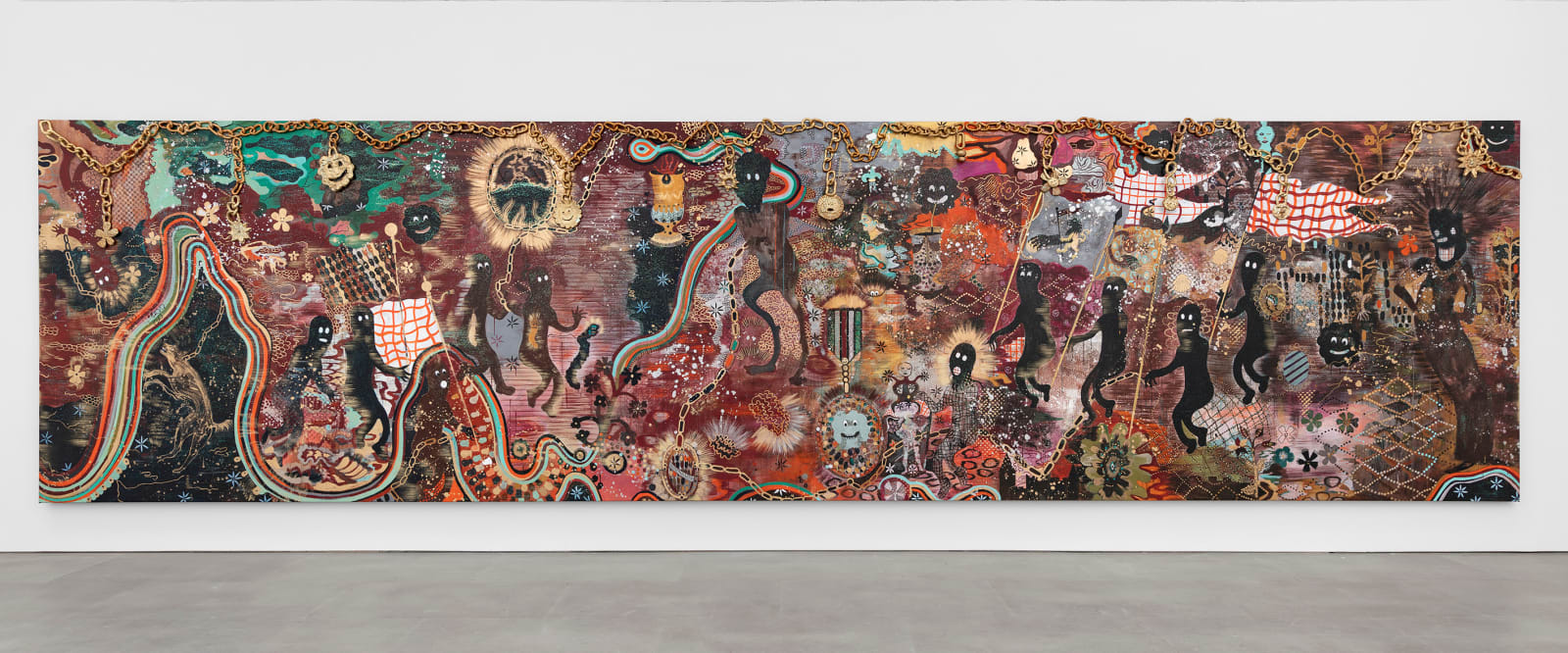Hélène Delprat FR, b. 1957
La bataille de San Romano camouflée, 2018
Pigment, paillettes et acrylique sur toile
Pigment, glitter and acrylic on canvas
Pigment, glitter and acrylic on canvas
245 x 950 cm
96 1/2 x 374 1/8 in
96 1/2 x 374 1/8 in
HD0980
© Hélène Delprat, Adagp, Paris, 2020.
Processes of citation and translation abound in the work of Hélène Delprat. An indefatigable collector of both contemporary and historical imagery and texts, Delprat’s references serve as a spark or...
Processes of citation and translation abound in the work of Hélène Delprat. An indefatigable collector of both contemporary and historical imagery and texts, Delprat’s references serve as a spark or catalyst, yet the final result holds little respect for the original. She deforms, amplifies, exaggerates and multiplies her source material to create assemblages that are, as the artist says herself, “at times chaotic, a kind of montage and magnetization of forms and ideas that comes together in different ways.” Such assemblages, which can be destroyed at any time, thus imbue the images with another meaning and allow them to tell another story.
The artist discribed her painting as a « sort of Fight between the Lapiths and the Centaurs (Piero di Cosimo, 1490) or the Battle of San Romano (Paolo Uccello, 1456) ridiculous and wrecked ... A scene of battle or war with decorations, medals and other happy smileys. It is not a history painting it is a story. I have always been interested in war facts, battle scenes and armor. Broken centaurs, chains, standards, ornaments, (we find in other paintings this motif of flags in crossed orange lines - standard of my Autonomous Territory, spears, armor...). The armors are paradoxically tools of defense or pomp of great sophistication: why so much beauty, why the goldsmith's trade to fight. These complex engraved patterns, which can also be found on silverware, make the body beautiful, radiating like an apparition and protect it: Elegant warfare. »
The artist discribed her painting as a « sort of Fight between the Lapiths and the Centaurs (Piero di Cosimo, 1490) or the Battle of San Romano (Paolo Uccello, 1456) ridiculous and wrecked ... A scene of battle or war with decorations, medals and other happy smileys. It is not a history painting it is a story. I have always been interested in war facts, battle scenes and armor. Broken centaurs, chains, standards, ornaments, (we find in other paintings this motif of flags in crossed orange lines - standard of my Autonomous Territory, spears, armor...). The armors are paradoxically tools of defense or pomp of great sophistication: why so much beauty, why the goldsmith's trade to fight. These complex engraved patterns, which can also be found on silverware, make the body beautiful, radiating like an apparition and protect it: Elegant warfare. »
Provenance
- Atelier de l'artiste, Paris (FR)- Galerie Christophe Gaillard, Paris (FR)
Exhibitions
- Hélène Delprat, Écoutez ! C'est l'éclipse, Fondation Marguerite et Aimé Maeght, Saint-Paul-de-Vence (FR), 2025- Le Souvenir des batailles perdues, Museu Picasso, Barcelone (ES), 2023
Literature
- Élodie Antoine, Retour sur l’œuvre d’Hélène Delprat à la fondation Maeght, Le Journal des Arts, n° 654, 25 avril 2025, p.18- Joséphine Blindé, Hélène Delprat va réaliser la scène manquante de la tapisserie de Bayeux, Beaux Arts Magazine, 5 novembre 2024, en ligne
- Chloë Cambreling, France Culture, Les Midis de Culture, Hélène Delprat, artiste : "La peinture n'est pas faite pour être belle" 26 novembre 2025, en ligne
